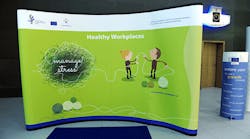The Annual Report 2015 for the European Agency for Safety and Health at Work (EU-OSHA) outlines the highlights of the year, which were characterized by anticipating and adapting to change in the world of work, and tackling the risks and challenges emerging from these changes. The year also saw the close of EU-OSHA’s Healthy Workplaces Manage Stress campaign.
“More and more, work is being relocated outside traditional workplaces, workplaces are becoming increasingly competitive and technologies are developing rapidly,” said EU-OSHA Director Christa Sedlatschek, highlighting how change was an underlying theme of 2015. “Demographic change is seeing Europe’s workforce ageing. In 2015, EU-OSHA published expert review articles on three new and emerging risks and their impact on occupational safety and health (OSH): crowdsourcing, performance-enhancing drugs and robotics.”
The year was an important time for one of EU-OSHA’s flagship projects, the European Survey of Enterprises on New and Emerging Risks (ESENER). The results of ESENER-2 show that the most widespread risks in European workplaces are psychosocial risks (58 percent of workplaces in the EU report that difficult customers are a risk factor) and those related to musculoskeletal disorders (56 percent report tiring or painful working positions). ESENER-2 also highlights the importance of risk assessment in tackling risks. These results now can be explored using EU-OSHA’s new interactive online survey dashboard.
In September, the main findings of EU-OSHA’s pilot project on older workers – “Safer and Healthier Work at Any Age,” were presented to policy-makers, OSH professionals and social partner representatives in Brussels. During this conference, discussion sessions focused on ageing, OSH and gender and rehabilitation and return-to-work systems.
The results of the evaluation of EU-OSHA’s Online Interactive Risk Assessment (OiRA) project https://osha.europa.eu/en/tools-and-publications/seminars/safer-and-healthier-work-any-age showed that stakeholders are very satisfied with how the project is developing. By the end of 2015, the total number of OiRA tools was 86, with another 30 under development. And a new user interface, OiRA 2.0, aiming to improve user experience, was also launched. Ending the year on a high, the OiRA project was awarded a Best Practice Certificate by the European Public Sector Award scheme in November.
The Healthy Workplaces Summit, marking the end of the Healthy Workplaces Manage Stress campaign, was held in Bilbao in November, dedicated to the memory of Dr Eusebio Rial González (1966-2014). Over 300 OSH professionals, policy-advisers and decision-makers, among others, attended.

